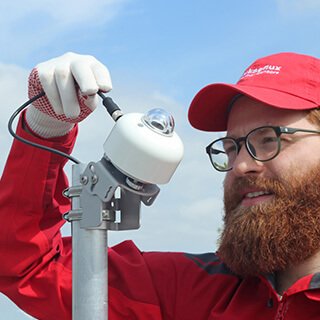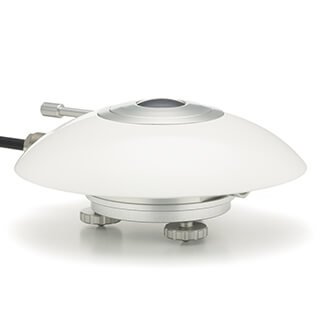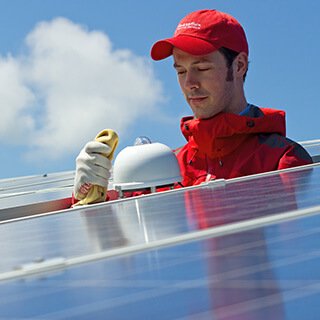5 FAQs about solar radiation measurement
This article answers 5 Frequently Asked Questions about solar radiation measurement. We will start by briefly explaining solar radiation. Then, we will explain how to measure it reliably and why such measurements are important. Next, we will explain what a normal solar radiation reading is. Finally, we will discuss how solar radiation can be forecasted.
1. What is solar radiation?
The sun is an immensely hot sphere that radiates energy due to nuclear fusion reactions at its centre. The energy emitted at the surface is called solar radiation. This energy consists of electromagnetic waves, both visible and invisible. Figure 1 shows the distribution of all the different wavelengths.
The wavelength distribution for sunlight is as follows:
- 49% consists of infrared wavelengths
- 43% consists of the visible wavelengths
- 7% consists of ultraviolet wavelengths
- < 1% consists of radio waves, microwaves, x rays and gamma rays
Solar radiation is characterised as shortwave radiation. In the earth’s atmosphere, it interacts with clouds and other molecules and eventually reaches the surface, where it is reflected and absorbed. This heats up the surface, which then emits radiation in the longwave spectrum.
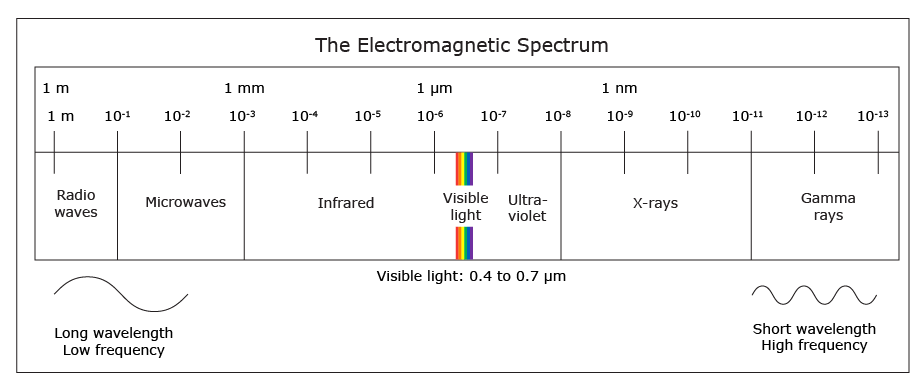
2. How can you measure solar radiation?
Solar radiation can be measured locally (ground-based measurements) or remotely (using satellites). This radiation is quantified in watts per square meter [W/m2]. Local measurements are done using sensors like pyranometers, as shown in Figure 2. These solar radiation sensors absorb radiation, measure the change in heat, and relate this to the amount of incoming radiation.
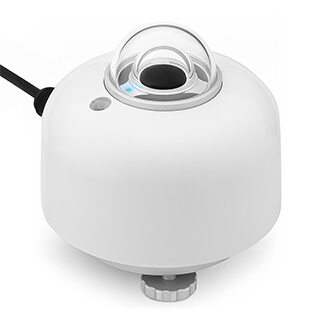
manufactured by Hukseflux.
Remote solar radiation measurements are based on estimates and often use the following steps:
- Detecting cloud cover: First, cloud cover is detected by taking satellite images of the earth and comparing them to photos without cloud cover.
- Estimating cloud properties: Next, the thickness and height of the cloud cover are estimated by analysing satellite images from different spectral bands. This is important in deciding how much solar radiation the clouds reflect and how much reaches the earth. As the introduction explains, solar radiation also consists of wavelengths other than visible light. Therefore, images taken in the infrared and ultraviolet parts of the spectrum are also crucial for better understanding cloud properties.
- Calculating solar radiation: Then, scientific models are used to calculate how much solar radiation reaches the earth in clear-sky conditions. These models can make accurate estimations of the irradiance based on the coordinates of the location of interest and the time of day and year.
- Combining Data for Solar Radiation Estimation: In the final step, the data from steps 2 and 3 can then be combined to derive a value for the solar radiation per pixel of the satellite images. Modern satellites can have a resolution of up to 500 by 500 meters per pixel.
Crucially, though, the irradiance calculated by satellites is an estimation. The accuracy of these models must be verified using local ground-based radiation measurements, because they are the most accurate. We will now examine how these ground-based measurements can be made.
The first step is to find a sensor that fits the application. Our article: Measuring sunlight: what instrument to use? provides a detailed description of this. In short, the article explains the different types of solar radiation that can be measured.
First, the solar radiation spectrum can be decomposed into longwave and shortwave radiation. Longwave radiation (the infrared part of the spectrum) can be reliably and accurately measured by our pyrgeometers. Shortwave radiation is the part of the spectrum that is mainly utilised by solar panels to convert to solar energy. This radiation can be further decomposed to highlight how it reaches the surface.
The radiation that reaches the surface without obstruction is called the Direct Normal Irradiance (DNI). This can be measured by our pyrheliometers. These always need to be pointed at the sun and are, therefore, mounted on a solar tracker.
Other radiation does not reach the surface directly, but is scattered or diffused by the atmosphere. This is called the Diffuse Horizontal Irradiance (DHI). The DHI can be measured by our pyranometers in combination with a shading object that blocks the DNI. If such a shading object is not used, though, the pyranometers measure both the DNI and DHI. The combination of these two is called the Global Horizontal Irradiance (GHI).
More information on how these sensors can reliably measure solar radiation can be found in our articles: What is a pyrgeometer? and Solar radiation sensors: become a pyranometer expert.
3. Why should you measure solar radiation?
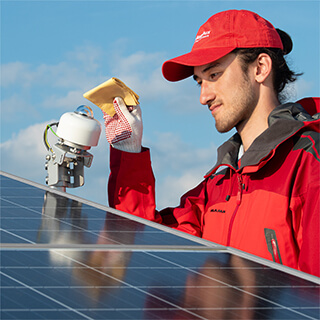
to monitor the solar radiation
on a solar panel.
Solar radiation is significant in many important fields, such as climatology, meteorology, building design, and more. Therefore, accurate solar radiation measurements are crucial in expanding our knowledge and aiding decision-making. Another field that has become popular in the last decade is related to solar energy. We will focus on this in the next section.
Solar panels have become the main contributor to our transition to clean electricity generation. Solar radiation measurements are aiding this transition in several ways. For example, since a large-scale solar farm is a significant investment, generating electricity must be maximised with the available funding.
Performing measurements with pyranometers and pyrheliometers is crucial in deciding the solar panels' location, orientation, and tilt to maximise the energy yield. The measurements are helpful not only during the design, but also after it is built. During operation, the measurements allow for performance monitoring to identify any issues on time. Figure 3 shows an example of how our SR300-D1 pyranometer can be used to monitor the solar radiation on a solar panel.
Furthermore, showcasing that your solar farm works as promised during its design can be part of a contractual obligation. Providing solar radiation measurements alongside your solar farm data can be necessary to demonstrate that the benchmarks are met.
Our article: Solar energy meters: why use them in measuring solar energy provides more information on this.
4. What is a normal solar radiation reading?
Because the amount of solar radiation measured depends on many factors, there is no “single” normal solar radiation reading. We can, however, examine specific cases and determine what value a measurement could yield. We can start by reviewing the solar radiation at the top of earth’s atmosphere. When averaged over a year, this solar radiation is roughly in the 1360-1370 W/m2 region and is called the solar constant.
As mentioned, the radiation reaching earth depends on many factors, mainly related to atmospheric conditions and how long the radiation travels through the atmosphere.
First, let’s simplify by assuming clear-sky conditions in the summer solstice and comparing the irradiance in Delft (farther north), the Netherlands, and Quito, Ecuador (close to the equator).
In Delft, the irradiance is approximately 850-900 W/m2, while in Quito, it is around 1000-1100 W/m2. Both are significantly lower than the solar constant, and further from the equator (in Delft), the irradiance is lower than near the equator. This is because, even though no clouds are assumed, atmospheric particles still interact with the radiation, leading to reflection and absorption before reaching the earth’s surface. This is why the irradiance decreases as you move farther from the equator. The radiation has to travel a longer path through the atmosphere, interacting with more particles.
Similarly, the time of year also influences irradiance. For example, on the winter solstice in Delft, the irradiance in the middle of the day is 200-300 W/m2. This is, again, because solar radiation has to travel longer through the atmosphere. The same holds for the time of day, where the radiation travels longer through the atmosphere in the early and late hours due to the sun's low angle.
We simplified the above situations by assuming clear-sky conditions. However, such conditions are not always realistic (especially in the Netherlands). Quantifying how much cloudy conditions impact the irradiance in a single number is difficult since there is a wide range of possible clouds with different impacts on reflection and absorption.
5. How do you predict solar radiation?
Solar radiation prediction is related to the measurement method in question 2. The most mature methods use the same satellite data to estimate the irradiance. These methods, called Numerical Weather Predictions (NWPs), aim to model atmospheric processes. The development of these processes depends on many parameters, making the models very complex. Forecasts of a wide range of parameters can then be made for the coming 48 hours at hourly intervals; however, these forecasts can take multiple hours to calculate due to the complexity. Again, pyranometer measurements serve a crucial role in evaluating the forecasts.
Recently, newer methods have also relied on pyranometer measurements to perform irradiance forecasts. These methods use machine learning and deep learning models to overcome the complexity of the NWPs and make faster and possibly more accurate forecasts. By training these models on years of irradiance data from pyranometers, they can find underlying patterns in the data without assuming the underlying and complex physical nature of the problem.
Conclusion
This article answered 5 frequently asked questions regarding solar radiation and its measurements. If you still have unanswered questions or are further interested, be sure to check out the other articles in our Library or contact us.








